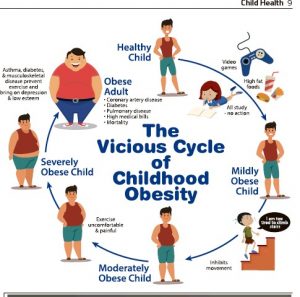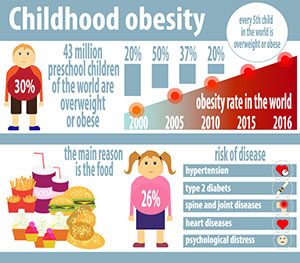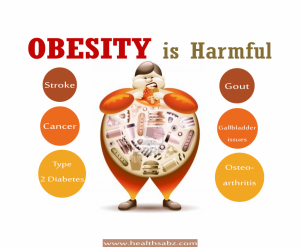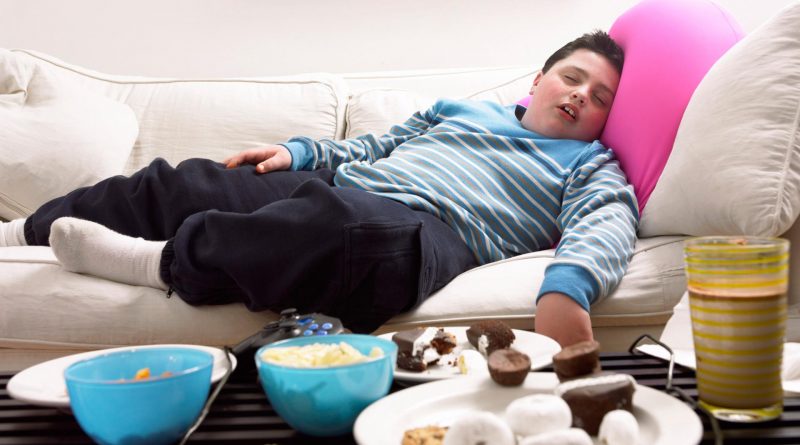Raise Healthy, Not Obese Kids!
Childhood obesity has become a serious public health concern as obese kids are prone to developing diabetes, heart disease, sleep problems, cancer, and other life-threatening disorders, leading to increased mortality rates during adulthood. With more than 42 million overweight children around the world, parents need to change the diet and lifestyle of their offspring by ensuring healthy food, increasing physical activity, and decreasing sedentary habits among kids
By Amresh K Tiwary
Obesity is no longer an issue only in affluent countries. It is on the rise in less developed countries too with childhood obesity becoming a worrisome trend. According to a report, in 2016, more than a third of adults worldwide were classified as overweight or living with obesity, as were 41 million children younger than 5 years.
 Obesity affects people of all ages, all regions, and all socio-economic backgrounds. One of the common causes of child obesity is immobile activities like computer usage, playing video games or watching television, and consuming calorie-dense, prepared snacks. So, if your child develops habits like extra intake of food, living a sedentary lifestyle, eating junk food and excessive TV viewing, you have reasons to be worried. Your child may become obese and overweight.
Obesity affects people of all ages, all regions, and all socio-economic backgrounds. One of the common causes of child obesity is immobile activities like computer usage, playing video games or watching television, and consuming calorie-dense, prepared snacks. So, if your child develops habits like extra intake of food, living a sedentary lifestyle, eating junk food and excessive TV viewing, you have reasons to be worried. Your child may become obese and overweight.
According to a survey, 25 percent children under the age of 6 to 12 develop obesity in European and American countries, while in India it is 6 to 8 percent. Childhood obesity leads to life-threatening conditions including diabetes, heart disease, sleep problems, cancer, and other disorders. Some more complications include liver disease, early puberty or menarche, eating disorders such as anorexia and bulimia, skin infections, asthma and other respiratory problems.
“Overweight children are more likely to grow up as overweight adults. Obesity during adolescence has been found to increase mortality rates during adulthood. Obese children often suffer from teasing by their peers. Some are harassed or discriminated against by their own family. The excess body fat negatively affects a child’s health or well-being.”
Dr S K Mittal, Director Paediatrics, Max Superspeciality Hospital, Vaishali, Ghaziabad
Dr S K Mittal, Director Paediatrics, Max Superspeciality Hospital, Vaishali, Ghaziabad, says, “Overweight children are more likely to grow up as overweight adults. Obesity during adolescence has been found to increase mortality rates during adulthood. Obese children often suffer from teasing by their peers. Some are harassed or discriminated against by their own family. The excess body fat negatively affects a child’s health or well-being.”
As methods to determine body fat directly are difficult, the diagnosis of obesity is often based on Body Mass Index (BMI). Due to the rising prevalence of obesity in children and its many adverse health effects, it is being recognised as a serious public health concern. The term overweight rather than obese is often used in children as it is less stigmatising
“The BMI is acceptable for determining obesity for children of two years of age and older. It is determined by the ratio of weight to height. The normal range for BMI in children varies with age and gender. While a BMI above the 85th percentile is defined as overweight, a BMI greater than or equal to the 95th percentile is defined as obese by the Centre for Disease Control and Prevention. It has published tables for determining this in children,” informs Dr S K Mittal.
With more than 42 million overweight children around the world, childhood obesity is increasing worldwide. Since 1980, the number of obese children has doubled in all three North American countries, Mexico, the United States, and Canada. In 2010, 32.6 percent of 6 to 11-year-olds were overweight, and 18 percent of 6 to 9-year-olds were obese. Although the rate of childhood obesity in the United States has stopped increasing, it nevertheless remains high.
 Dr S K Mittal elaborates, “Childhood obesity can be brought on by a range of factors which often act in combination. Environment is the medical term set aside for this mixture of elements. The greatest risk factor for child obesity is the obesity of both parents. This may be reflected by the family’s environment and genetics. Other reasons may also be due to psychological factors and the child’s body type.”
Dr S K Mittal elaborates, “Childhood obesity can be brought on by a range of factors which often act in combination. Environment is the medical term set aside for this mixture of elements. The greatest risk factor for child obesity is the obesity of both parents. This may be reflected by the family’s environment and genetics. Other reasons may also be due to psychological factors and the child’s body type.”
A recent review stated that childhood obesity is the result of the interaction of natural selection favouring those with more parsimonious energy metabolism and today’s consumerist society with easy access to energy dense cheap foods and less energy requirements in daily life.
Obesity is a major feature of a number of rare genetic conditions often present in childhood: Childhood obesity is often the result of interplay between many genetic and environmental factors. Over 200 genes affect weight by determining activity level, food preferences, body type, and metabolism. In children with early severe obesity (defined by an onset before ten years of age and body mass index over three standard deviations above normal), 7 per cent harbour a single locus mutation. One study found that 80 per cent of the offspring of two obese parents were obese in contrast to less than 10 per cent of the offspring of two parents who were of normal weight. The percentage of obesity that can be attributed to genetics varies from 6 per cent to 85 per cent depending on the population examined.
According to Dr Anup Mohta, Senior Paediatric Surgeon, New Delhi, “In the recent decades, family practices have significantly changed, and several of these practices greatly contribute to childhood obesity. With a decreasing number of mothers who breast-feed, more infants become obese children as they grow up. Fewer children go outside and engage in active play as they remain hooked to technologies such as the television and video games. Rather than walking or biking to a bus-stop or directly to school, more school-age children are driven to school by their parents, reducing physical activity. As family sizes decrease, the children’s pester power, their ability to force adults to do what they want, increases. This ability enables them to have easier access to calorie-packed foods, such as candy and soda drinks.”
The first problems to occur in obese children are usually emotional or psychological. Obese children often suffer from teasing by their peers. Some are harassed or discriminated against by their own family. Stereotypes abound and may lead to low self-esteem and depression.
Dr Anup Garg, Senior Paediatric Specialist, Apollo Hospital, Noida, says, “Children are more at risk for adult health problems such as heart disease, type 2 diabetes, stroke, several types of cancer, and osteoarthritis. One study showed that children who became obese as early as the age two are more likely to be obese as adults. All of these health effects are contributing to a shorter lifespan for these obese children.”
Dr Anup Mohta adds, “Schools play a large role in preventing childhood obesity by providing a safe and supporting environment with policies and practices that support healthy behaviours. At home, parents can help prevent their children from becoming overweight by changing the way the family eats and exercises together. The best way children learn is by example, so parents need to lead by example by living a healthy lifestyle.”
“In the recent decades, family practices have significantly changed, and several of these practices greatly contribute to childhood obesity. With a decreasing number of mothers who breast-feed, more infants become obese children as they grow up. Fewer children go outside and engage in active play as technologies, such as the television and video games, keep children indoors. Rather than walking or biking to a bus-stop or directly to school, more school-age children are driven to school by their parents, reducing physical activity.”
Dr Anup Mohta, Senior Paediattic Surgeon. New Delhi
“The effects of eating habits on childhood obesity are difficult to determine. A three-year randomised controlled study of 1,704 3rd grade children who provided two healthy meals a day in combination with an exercise programme and dietary counselling failed to show a significant reduction in the percentage of body fat when compared to a control group. This was partly due to the fact that even though the children believed they were eating less; their actual calorie consumption did not decrease with the intervention. At the same time, observed energy expenditure remained similar between the groups. This occurred even though dietary fat intake decreased from 34 per cent to 27 per cent. A second study of 5,106 children showed similar results. Even though the children ate an improved diet there was no effect found on BMI,” Dr Anup Garg elaborates.


Dr Sachin Bhargav, Senior Child Specialist, says, “The studies show that curbing childhood obesity has not had the desired effect due to the interventions not being sufficient enough. Changes were made primarily in the school environment while it is felt that they must occur in the home, the community, and the school simultaneously to have a significant effect. The calorie-rich drinks and foods are readily available to children. Consumption of sugar-laden soft drinks may contribute to childhood obesity. In a study of 548 children over a 19 month period the likelihood of obesity increased 1.6 times for every additional soft drink consumed per day.”
“The calorie-dense, prepared snacks are available in many locations frequented by children. Research suggests that the increase in availability of junk foods in schools can account for about one-fifth of the increase in average BMI among adolescents over the last decade. Eating at fast food restaurants is very common among young children with 75 per cent of 7th to 12th grade students consuming fast food in a given week.”
Dr H P Singh, Senior Child Specialist, Mother & Child Care Clinic, Vaishali, Ghaziabad
Dr H P Singh, Senior Child Specialist, Mother & Child Clinic, Vaishali, Ghaziabad, agrees, “The calorie-dense, prepared snacks are available at many locations frequented by children. Research suggests that the increase in availability of junk foods in schools can account for about one-fifth of the increase in average BMI among adolescents over the last decade. Eating at fast food restaurants is very common among young children with 75 per cent of 7th to 12th grade students consuming fast food in a given week.”
The fast food industry is also at fault for the rise in childhood obesity. This industry spends about $4.2 billion on advertisements aimed at young children. McDonald’s alone has 13 websites that are viewed by 365,000 children and 294,000 teenagers each month. In addition, fast food restaurants give out toys along with children’s meals, which help to entice children to buy fast food. An estimated 40 percent of children ask their parents to take them to fast food restaurants on a daily basis.
To make matters worse, out of 3000 combinations created from popular items on children’s menus at fast food restaurants, only 13 meet the recommended nutritional guidelines for young children. Some literature has found a relationship between fast food consumption and obesity. Particularly, fast food restaurants near schools increase the risk of obesity among the student population.
Whole milk consumption in children of one to two years of age had no effect on weight, height, or body fat percentage. Therefore, whole milk continues to be recommended for this age group. However the trend of substituting sweetened drink for milk has been found to lead to excess weight gain.
 Dr S K Mittal observes, “Physical inactivity of children has also shown to be a serious cause, and children who fail to engage in regular physical activity are at greater risk of obesity. The researchers studied the physical activity of 133 children over a three-week period using an accelerometer to measure each child’s level of physical activity. They discovered the obese children were 35 per cent less active on school days and 65 per cent less active on weekends compared to non-obese children.”
Dr S K Mittal observes, “Physical inactivity of children has also shown to be a serious cause, and children who fail to engage in regular physical activity are at greater risk of obesity. The researchers studied the physical activity of 133 children over a three-week period using an accelerometer to measure each child’s level of physical activity. They discovered the obese children were 35 per cent less active on school days and 65 per cent less active on weekends compared to non-obese children.”
“Physical inactivity in a child could result in lethargy as an adult. In a fitness survey of 6,000 adults, researchers discovered that 25 per cent of those who were considered active at ages 14 to 19 were also active adults, compared to 2 per cent of active adults who were inactive in the same age-group. Staying physically inactive leaves unused energy in the body, most of which is stored as fat,” Dr Mittal, adds.
Many children fail to exercise because they are spending time doing immobile activities such as computer usage, playing video games or watching television. Technology has a large factor on the children’s activeness. Researchers provided a technology questionnaire to 4,561 children, aged 14, 16, and 18. They discovered children were 21.5 per cent more likely to be overweight when watching 4+ hours of TV per day, 4.5 per cent more likely to be overweight when using a computer one or more hours per day, and unaffected by potential weight gain from playing video games. A randomised trial showed that reducing TV viewing and computer use can decrease age-adjusted BMI. Reduced calorie intake was thought to be the greatest contributor to the BMI decrease.
In a 2009 preschool study, 89 per cent of a pre-schoolers’ day was found to be sedentary while the same study also found that even when outside, 56 percent of activities were still sedentary. One factor believed to contribute to the lack of activity found was little teacher motivation, but when toys, such as balls were made available, the children were more likely to play.
 Various developmental factors may affect rates of obesity. Breast-feeding, for example, may protect against obesity in later life with the duration of breast-feeding inversely associated with the risk of being overweight later on. A child’s body growth pattern may influence the tendency to gain weight. Researchers measured the standard deviation (weight and length) scores in a cohort study of 848 babies. They found that infants who had an SD score above 0.67 were less likely to be overweight compared to infants who had less than a 0.67 SD score (they were more likely to gain weight).
Various developmental factors may affect rates of obesity. Breast-feeding, for example, may protect against obesity in later life with the duration of breast-feeding inversely associated with the risk of being overweight later on. A child’s body growth pattern may influence the tendency to gain weight. Researchers measured the standard deviation (weight and length) scores in a cohort study of 848 babies. They found that infants who had an SD score above 0.67 were less likely to be overweight compared to infants who had less than a 0.67 SD score (they were more likely to gain weight).
A child’s weight may be influenced when he/she is only an infant. Researchers also did a cohort study on 19,397 babies, from their birth until age seven and discovered that fat babies at four months were 1.38 times more likely to be overweight at seven years old compared to normal weight babies. Fat babies at the age of one were 1.17 times more likely to be overweight at age seven compared to normal weight babies.
The escalation of obese children is due to the upsurge of technology, increase in snacks and portion size of meals, and the decrease in the physical activity of children. If children were more mobile and less sedentary, the rate of obesity would decrease. Children have to put down the electronic devices and spend more time outside playing or exploring other options of physical activity. Parents have to recognize the signs and encourage their children to be more physically active. There are many programmes designed to encourage activities to help combat problems with this epidemic of obesity.
Exclusive breast-feeding and time spent outdoors have several nutritional and other beneficial effects. Parents changing the diet and lifestyle of their offspring by offering appropriate food portions, increasing physical activity, and keeping sedentary behaviours at a minimum may also decrease the obesity levels in children.




